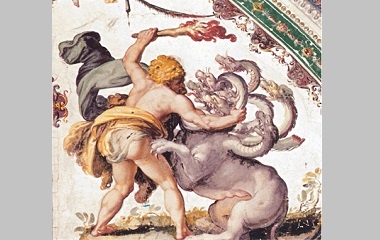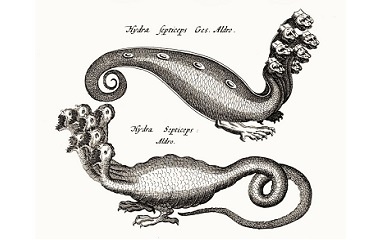What is the Hydra?
The Hydra is an immortal, many-headed snake who haunted the swamps around Lake Lerna in ancient Greece. Although the monster claimed hundreds of victims, it is most famous for its battle with the hero Heracles.
Characteristics
Physical Description
The Hydra was literally multiple times more ferocious than its closest relative: the snake. Not only was this swamp-dwelling monster larger than any known snake, it had somewhere between six and one hundred heads!
Each of the Hydra’s heads was supported by a long neck, so the heads could coil around each other or fan out and attack challengers from every angle. Eventually, all those necks welded together into a fat tail, which trailed along the ground behind the monster. Some show the tail forking at the end into two or more small tails.
Personality
The Hydra had a nasty personality to match its horrid appearance. From birth, the goddess Hera trained the monster to attack and destroy anything that fell beneath its gaze. It ravaged innocent villages around its home, Lake Lerna, devouring hundreds of victims.
When the Hydra wasn’t filling its stomach with human flesh, it slumbered in a deep swamp cave (which was rumored to be one of the entrances to the underworld). Only hunger or rage could draw the beast out of its lair; otherwise, it was mindless and lazy.
Special Abilities
It’s no mistake that Hera chose the Hydra as one of Heracle’s Eleven Tasks. This monster had powers that could easily send a hero to the underworld.
First, the Hydra’s blood was full of super-toxic poison. Some men died simply from approaching the beast’s lair and smelling its poisonous blood and breath. Even after the Hydra was slaughtered, its blood was used as a weapon that brought down many strong fighters.
Second, the Hydra was immortal and had regenerative abilities. The monster had one, immortal head, which was protected by the other, deadly heads that grew around it. If any of the mortal heads were cut off, two or more heads would sprout from the monster’s body to replace the loss. The beast could only be killed by cutting off the immortal head—a near impossible text.
Related Characters
The Hydra was the offspring of Greek’s two earliest monsters: Typhon, an immortal giant, and Echidna, half-woman and half-snake. Together, they gave the Hydra its immortality, monstrous shape, and evil disposition.
Hera, wife of Zeus, adopted the Hydra when it was a baby. She raised the creature with the intent of using it to destroy Heracles—finding a home for it, protecting it from harm, and nurturing its destructive impulses.
When Heracles finally encountered the Hydra, all Hera’s training was put to the test. The monster very nearly killed the hero. He only managed to kill it with the help of his quick-witted nephew, Iolaus.
Stories
Heracles vs. the Hydra
Heracles was the son of Zeus, but he wasn’t the son of Zeus’s wife, Hera. Shortly after Heracles was born, Hera found out about Zeus’s infidelity and demanded that he banish his son from Mt. Olympus. But even that punishment wasn’t enough for Hera. As she watched the golden boy grow into a young Greek hero, she grew angrier and angrier still.
When an oracle told Heracles that, to gain immortality, he must complete twelve impossible tasks, Hera saw a golden opportunity to get rid of the boy once and for all. She adopted the Hydra and began training it to be one of Greek’s most fearsome monsters—a monster that would be almost impossible to kill. Sure enough, slaying the Hydra became one of Heracles twelve tasks, much to Hera’s delight.
Heracles entered the Lernaean swamp with his mouth and nose covered in thick fabric, so that he wouldn’t breathe the monster’s poisonous scent. He crept to the cave around the Spring of Amymone, where the monster slept, and shot fiery arrows into it. After a few areas, the Hydra charged out of the cave, ready to tear its assailant to shreds. But Heracles was ready too. He began cutting off the Hydra’s heads as fast as he could. Though the monster shrieked in pain, the injuries were far from life-threatening. In fact, they only made the Hydra stronger, as several new heads grew to replace each one that was lost.
After a few minutes of bloody battle, Heracles realized that he could never defeat the Hydra alone. Desperate, he called to his nephew, Iolaus, who brought a torch and began burning the bloody stumps as fast as Heracles cut off the Hydra’s heads. The cauterized stumps prevented knew heads from growing.
When Hera saw that Heracles and Iolaus had found a way to kill her monster, she was so angry that she sent a giant crab to distract Heracles. He crushed this under his foot.
At last, Heracles hacked his way to the Hydra’s lone, immortal head. He cut this off with a golden sword, given to him by Athena, and buried it under a huge rock.
Despite the fact that he had slaughtered the horrible Hydra, some people claimed that Heracles had not completed the task because he had asked Iolaus for help.
The Hydra Avenged
After Heracles killed the Hydra, he dipped some of his arrows in the monster’s toxic blood. He used these arrows to kill new enemies, who didn’t stand a chance against the poison.
A centaur named Nessus was one of the enemies who Heracles killed with his poisonous arrows. As he lay dying, Nessus beckoned to Heracles’ wife and told her that his blood, spilled by her husband, could be used as a love charm that would make her husband faithful to her for life. In fact, Nessus’ blood was tainted with Hydra poison and had become a deadly weapon itself. Not knowing this, Heracles’ wife dipped his clothes in the blood and gave them to him to wear. As soon as the cloth touched Heracles’ skin, the Hydra’s poison began to burn his flesh—and it burned until the hero was dead. Thus, in the end, the Hydra claimed Heracles’ life in return for its own.
Cultural Representation
Origin
In writing, the Hydra first appears in Hesiod’s Theogony, which dates back to around 700 BCE. Paintings and pottery suggest that the Hydra’s legend might be even older than this, possibly rising from Sumerian, Babylonian, and Assyrian religions.
After Hesiod introduce the Hydra, it was embellished by the likes of Ovid, Seneca, Plato, and Virgil. Originally, the serpent had six heads, and none of them regenerated, but as the story grew in fame, the monster grew in horror.
Modern Appearances
Today, the Hydra is not well-known as a standalone character, but it is still the first monster that comes to mind when people think of “Hercules” and his trials.
Interestingly, the Hydra—an unnatural creature—has made a name for itself in the natural sciences. In astronomy, constellations and technological tools have been named after the monster, and in taxonomy, a whole genus of tentacled sea creatures bear the monster’s name.











this helped me for my project
this help me for my project
help me with my project
this really help me with my progect
I’m doing a project on the hydra this is helphul =]
whats the publication date